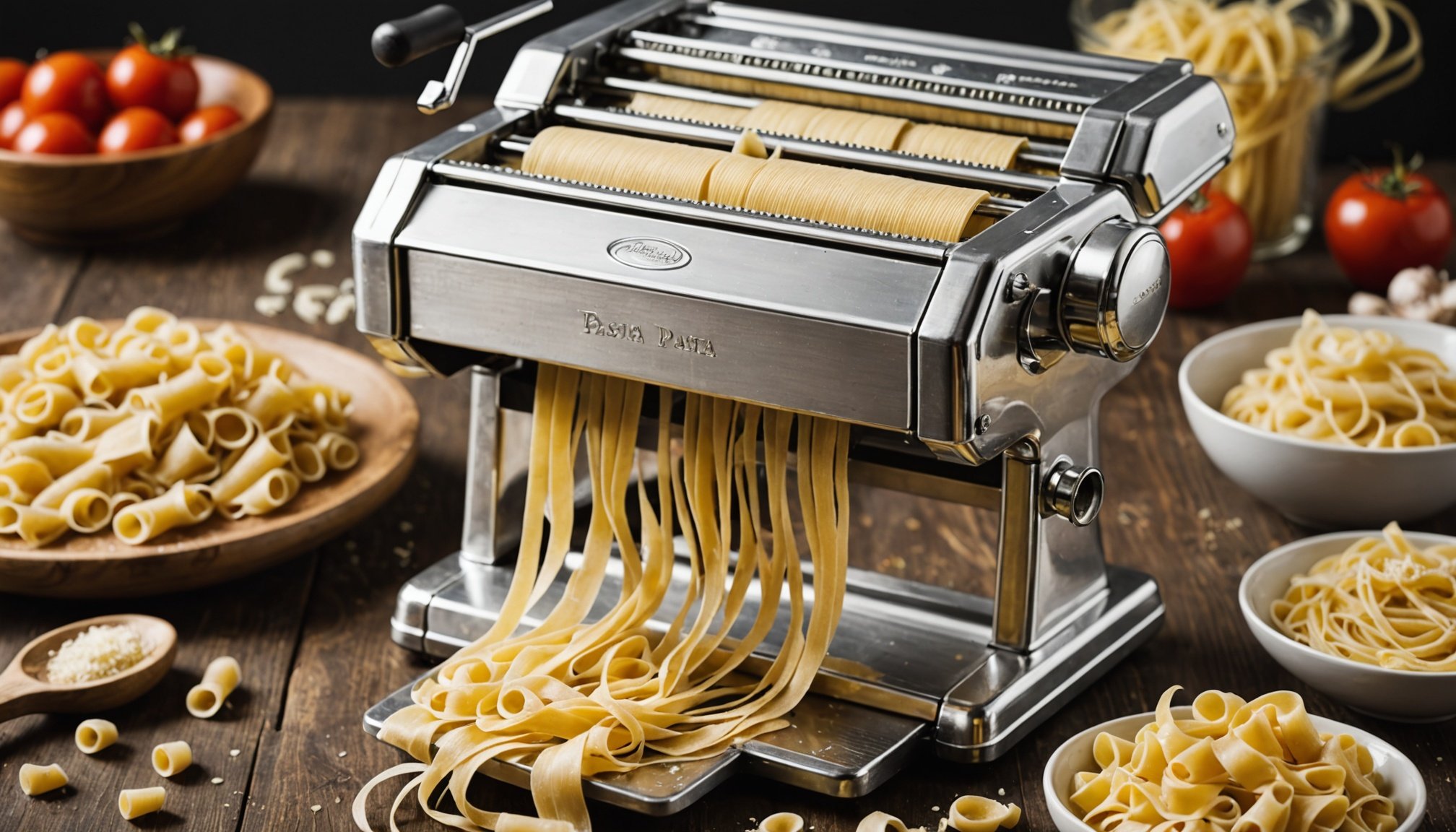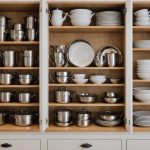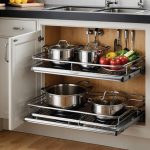Understanding Pasta Makers
The world of pasta makers offers diverse options to suit every culinary enthusiast’s needs. At the heart of this variety are the two main types of pasta makers: manual and electric.
Types of Pasta Makers
Manual pasta makers often capture the traditional essence of pasta-making, allowing the user to hand-crank the dough through the machine. This option is ideal for those who relish the hands-on experience. On the other hand, electric pasta makers automate the process, proving invaluable for those who prioritize convenience and speed.
Also read : Mastering sous vide: unlock the ideal temperature for succulent, moist chicken every time!
Manual vs Electric
Each has its own set of pros and cons. Manual pasta makers tend to be more affordable and portable. They require physical effort and time but offer precise control over thickness and texture. Conversely, electric versions reduce effort and can produce pasta quickly, although they often come at a higher price.
Factors to Consider
When deciding between these types, consider your cooking frequency and skill level. Novices or busy individuals may find electric models more appealing, while seasoned chefs might prefer the artisanal control of manual machines. Choose accordingly for a seamless homemade pasta experience.
In parallel : Key factors to weigh when selecting a spacious refrigerator for large households
Key Features to Consider
When selecting a pasta maker, focusing on essential features is crucial for an efficient and enjoyable experience. One of the most important attributes is the adjustable thickness settings. These settings provide flexibility in dough preparation, allowing users to customize pasta to their preferred thickness and style. Ease of use is another important consideration. A user-friendly design, which includes ergonomic handles and intuitive controls, enhances the overall pasta-making process, making it accessible even to beginners.
In electric pasta makers, safety features are paramount. Look for automatic shut-off functions and non-slip bases, which prevent accidents and ensure the appliance stays securely in place during operation. These safety elements are especially valuable if children might help in the kitchen, providing peace of mind alongside convenience.
To truly maximize your pasta-making endeavours, consider these crucial features when evaluating your options. Ensuring your chosen pasta maker has the perfect blend of adjustability, usability, and safety will enhance your culinary adventures and help create consistently delicious homemade pasta. Whether you’re a novice or a seasoned chef, understanding these features can significantly impact your pasta-making journey.
Durability and Build Quality
In the quest for a lasting investment, material quality plays a pivotal role in the longevity of a pasta maker. Traditional stainless steel is often prized for its long-lasting performance, resisting rust while enduring frequent use. On the other hand, some electric models utilise durable plastic components, which can be suitable if they’re of high-grade quality. Evaluating these materials is crucial for ensuring your pasta maker withstands the test of time.
Brand reputation is equally important in assessing durability and reliability. Trustworthy brands often come with a track record of satisfied customers, reflecting a commitment to high standards. Exploring real-world testimonials can provide insights into the average lifespan and performance of various models, helping prospective buyers make informed decisions.
Finally, consider experiences shared in product reviews. Real-world use cases from other pasta enthusiasts offer valuable guidance, highlighting how certain models hold up under typical kitchen conditions. This practical information underscores the significance of both material quality and brand reputation in selecting a dependable pasta maker, ensuring that your culinary adventures are supported by a resilient and long-lasting appliance.
Maintenance and Cleaning
Achieving optimal performance from your pasta maker involves consistent cleaning and maintenance. Each type of pasta maker demands different approaches. For manual models, cleaning typically involves using a dry cloth or brush to remove dough residues from the rollers and cutters, avoiding water to prevent rusting.
Meanwhile, electric pasta makers may have removable parts that can be washed gently. Always refer to your specific model’s manual for guidance on dishwasher compatibility. Ensuring that nets, screws, and nozzles are debris-free maintains operational efficiency.
Regular maintenance extends a pasta maker’s lifespan. Avoiçding heavy loads too frequently can preserve internal components. Lubricate metal parts as required, enhancing smooth operation.
Troubleshooting common issues can be straightforward with foresight. If dough consistently sticks, ensure it’s not overly moist and consult the manual for any model-specific advice. For mechanical faults, check for blockages or residue build-up.
By integrating these cleaning tips and maintenance practices into your routine, you can ensure your pasta maker delivers delicious results consistently. Basic upkeep nurtures both hygiene and the lasting functionality of your appliance.
Price Range and Budgeting
Navigating the world of pasta makers often starts by considering your budget. With options varying widely, it’s helpful to understand the cost comparison across types. Manual pasta makers generally range between £20 and £80, offering affordability and control. In contrast, electric pasta makers can span from £100 to over £500, reflecting their advanced features and convenience.
When assessing whether a pasta maker offers good value, evaluate its features against its price. Consider elements like adjustable settings, durability, and brand reputation to determine if a model aligns with your culinary needs. A higher cost doesn’t always equate to quality; hence, balance is key.
Scout deals and promotions strategically. Seasonal sales, manufacturer discounts, and bundled offers might present valuable opportunities. It’s also worth tracking online retailers for discounts, especially during significant shopping events.
By carefully evaluating price against utility, discerning buyers can secure a pasta maker that enriches their cooking experience without breaking the bank. Awareness of deals and promotions can further enhance your purchasing journey, ensuring you acquire a kitchen tool that offers both quality and affordability.
Customer Reviews and Recommendations
Researching customer reviews before purchasing can provide valuable insights into how a pasta maker performs in real-world settings. Feedback often highlights aspects like durability, ease of use, and the quality of pasta produced. Exploring these experiences helps build a clearer picture of each product’s strengths and weaknesses.
Analysing popular models unveils what users consistently praise. Many enthusiasts favour models from reputable brands that deliver robust performance and longevity. Reviews often mention machines that excel in features such as adjustable settings and user-friendly designs, underscoring their importance for a superior pasta-making experience.
When looking for top-rated pasta makers, consumers frequently commend products that combine quality materials with innovative features. Some models stand out due to their balance of affordability and functionality, ensuring they cater to both novice and seasoned chefs effectively.
Understanding what makes these options popular ultimately aids in making an informed decision. By sifting through user experiences, you can discern which pasta makers have earned their acclaim and meet their advertised promises. Therefore, investing time in reading recommendations can serve as a powerful tool in selecting a pasta maker that aligns with your culinary needs and expectations.
Tips for Perfecting Homemade Noodles
Creating the perfect homemade noodles involves mastering a few pasta-making techniques that can significantly enhance the texture and flavour of your pasta. Start with quality ingredients; use fresh eggs and high-grade flour to form a dough that’s neither too dry nor too sticky.
Techniques for Texture and Flavour
Achieving the ideal noodle texture often hinges on the kneading process. Knead until the dough becomes smooth and elastic, ensuring flexibility and strength. Then, let it rest. Resting allows gluten to relax, preventing shrinkage during rolling. For flavour, consider incorporating herbs or spices into the dough.
Avoiding Common Mistakes
One frequent error is rolling the dough too thick, which can lead to chewy noodles. Use adjustable settings on your pasta maker to ensure even thickness. Another common mistake is skipping the dusting of flour between rolls, which can cause sticking and tearing.
By following these essential tips, you can craft noodles that feel and taste professional. Understanding and applying proper techniques in dough preparation and rolling are crucial steps in achieving noodle perfection. Remember, practice makes perfect, and experimenting with flavours can lead to delightful culinary discoveries.











